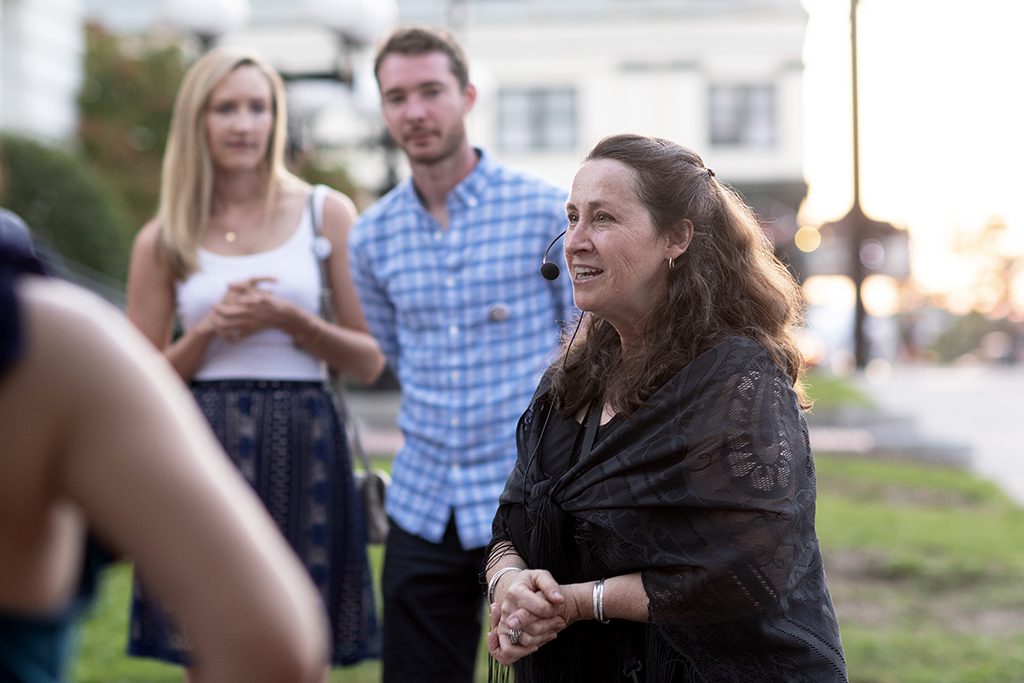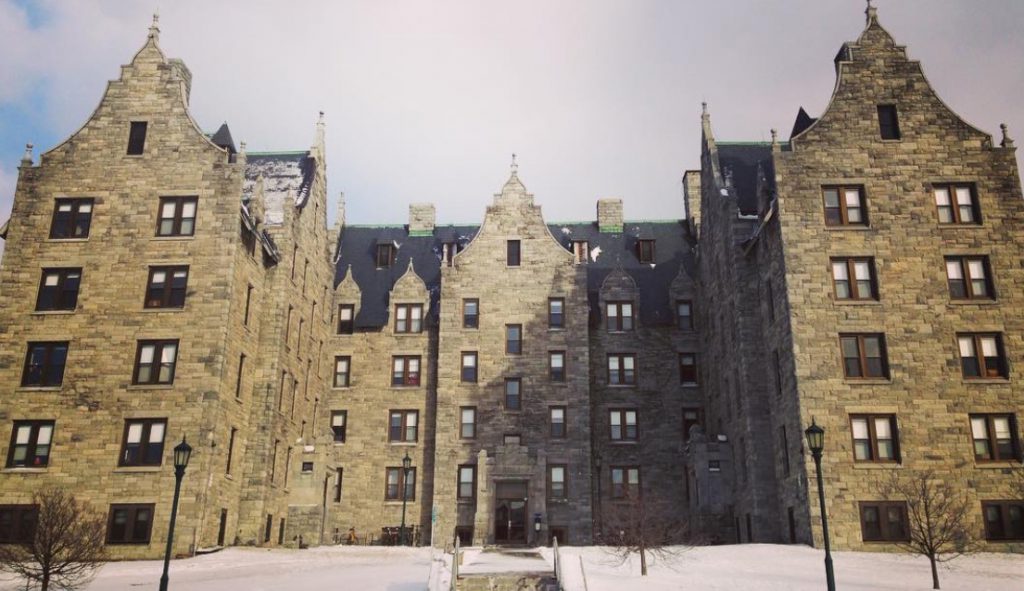
Thea Lewis Shares Tales of the Most Haunted Places in Burlington
October 18, 2018
If you take a walk around Vermont’s largest city, it won’t take long to come across some of the most haunted places in Burlington.
Just ask Thea Lewis, owner of Queen City Ghostwalk. Since 2002, Lewis has been offering haunted tours in Burlington and sharing legendary ghost stories about Vermont’s largest city.
In the summer and fall—right up until October 31–Lewis leads a variety of tours that highlight entertaining tales of phantom ships, historic resting places, serial killers, and haunted hot spots.
Lewis is the author of Wicked Vermont, as well as Haunted Burlington, Spirits of Vermont’s Queen City; Ghosts and Legends of Lake Champlain; and Haunted Inns and Ghostly Getaways of Vermont. If you want to learn more about Burlington’s haunted history, join Lewis for a Ghostwalk tour or pick up a copy of one of her books.
The Most Haunted Places in Burlington

Last month, I joined Lewis and 25 other people for a Darkness Falls walking tour. As the sun set over Lake Champlain, we strolled through alleys and listened to Lewis share stories of haunted places around town, including American Flatbread, Nectar’s, and the Flynn Center for the Performing Arts.
Dressed in a flowing black dress and shawl, Lewis shared with us interesting tidbits, such as how the notorious Ted Bundy was born in Burlington and that America’s first serial killer, H.H. Holmes, briefly lived in town. We learned about an old underground tunnel on St. Paul Street between TD Bank and The Vermont House building (the old Hotel Vermont) and tales of strange haunted happenings in that particular area.
For Lewis, a gifted storyteller, a good story makes a haunted place all the more compelling.
“A great haunt is always a good start, but I think storytelling makes the difference when it comes to interpreting history, haunted or otherwise,” she says. “I was a lackluster student of history until I realized it wasn’t just about dates and what famous people did 200 years ago. It was their stories. Who they fought with, what they gossiped about, what their weaknesses were.”
Some of her favorite haunted locations in Burlington include the Follett House on College Street and several historic buildings at UVM, such as Converse Hall, Waterman, Grassmount, and Williams.
Here are five of the most haunted places in Burlington:

Converse Hall at the University of Vermont
A ghost named Henry lives in UVM’s Converse Hall, a dorm built in the 1890s that is one of the oldest buildings on campus. According to Lewis, Henry was a medical student in the 1920s. He was a quiet and socially disengaged young man. Worried about his grades, he climbed up to the attic of Converse Hall and hanged himself after taking his exams. Since his death, Henry has been known to lock doors and move furniture around. Lewis has found that many students who have lived in Converse over the years aren’t frightened by Henry and are comfortable living along side of him.
The Follett House
The Greek Revival mansion on College Street, also known as the Pomerleau Real Estate building, was originally the home of Timothy Follett. Follett was born in 1793 in Bennington, graduated at age 17 from UVM and became state’s attorney in his 20s. Because of health reasons, he left his law career and became a businessman, investing in local shipping, lumber and railroad endeavors.
Eventually, his business enterprises failed and he lost his home to a business rival. Lewis says he died penniless in a sanitarium. Follett’s spirit may explain why employees report flickering lights and mysterious happenings in the building. To this day, Lewis says that guests on her haunted tours will see shapes passing by the mansion windows or peering onto the lawn.
American Flatbread
On St. Paul Street is American Flatbread, a popular restaurant in downtown Burlington. The structure, one of the oldest in Burlington, was built in the early 1800s by a smuggler. Lewis says the building contains all sorts of false walls and floors to hide things, including ghosts. Between the 1970s and 1990s, the building was home to Carbur’s restaurant. One of the restaurant’s chefs went down to the basement—which apparently includes old tunnels that once led to nearby buildings—and shot himself.
Over the years, there have been many strange occurrences in the building—plates flying off shelves and smashing on the floor, doors slamming and lights going on and off. Lewis suggests that the source of the haunting could go back centuries, originating with a man named Gideon King, known as “the admiral of the lake.” Between 1790 and 1820, King controlled most of the lake’s trade. He is also said to have built a network of tunnels that extended from the lake to major distribution points in the city. Those tunnels have since been closed off, but Lewis believes the spirits that populated the tunnels ended up relocating to Flatbread’s basement.
The Flynn Center for the Performing Arts
Built in 1930, the Flynn Theatre on Main Street was first designed for vaudeville performances and eventually shifted to a movie theater. Over the years, the building fell into disrepair but was restored in the 1980s. Today, the Flynn is a popular performing arts center, showcasing musical performances, stand-up comedy, and classic Broadway shows. Lewis says The Flynn Ghost is said to appear when volunteers are working late installing lights high above the seats on the catwalk. The theory is that the ghost is protective of volunteers because he doesn’t want them to take a tumble and end up like him.
Shanty on the Shore
Shanty on the Shore is a seafood restaurant overlooking Lake Champlain in a building that dates back to 1833. The building was originally Isaac Nye’s general store, located on a four-lot stretch of land and dock known as Nye’s Wharf. Nye purchased the land from Gideon King (mentioned above), whose family were some of the original landholders in Burlington. Lewis describes Nye as an eccentric fellow with a fondness for funerals. In his store, he rarely spoke unless spoken to. He didn’t drink, smoke or gamble.
Timothy Follett, the businessman who owned the Follett House on College Street, offered Nye money for the water rights behind the store. Nye refused and Follett took him to court. Apparently troubled by Follett’s actions, Nye closed his store and lived in a small room in the back of the building before he died in 1870. Nye’s request for his funeral was to be laid out on the counter of the store amid cobwebs and rotting goods. After all these years, some believe Nye’s spirit never left the building.
These days, footsteps can be heard overhead, glasses are seen rattling on their own, and chairs and tables are mysteriously moved up against the walls when no one is around.
Learn more about the most haunted places in Burlington in the Queen City Ghostwalk




No Comments